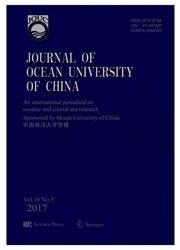

 中文摘要:
中文摘要:
The distribution of the suspended sediment concentration(SSC) in the Bohai Sea,Yellow Sea and East China Sea(BYECS) is studied based on the observed turbidity data and model simulation results.The observed turbidity results show that(i) the highest SSC is found in the coastal areas while in the outer shelf sea areas turbid water is much more difficult to observe,(ii) the surface layer SSC is much lower than the bottom layer SSC and(iii) the winter SSC is higher than the summer SSC.The Regional Ocean Modeling System(ROMS) is used to simulate the SSC distribution in the BYECS.A comparison between the modeled SSC and the observed SSC in the BYECS shows that the modeled SSC can reproduce the principal features of the SSC distribution in the BYECS.The dynamic mechanisms of the sediment erosion and transport processes are studied based on the modeled results.The horizontal distribution of the SSC in the BYECS is mainly determined by the current-wave induced bottom stress and the fine-grain sediment distribution.The current-induced bottom stress is much higher than the wave-induced bottom stress,which means the tidal currents play a more significant role in the sediment resuspension than the wind waves.The vertical mixing strength is studied based on the mixed layer depth and the turbulent kinetic energy distribution in the BYECS.The strong winter time vertical mixing,which is mainly caused by the strong wind stress and surface cooling,leads to high surface layer SSC in winter.High surface layer SSC in summer is restricted in the coastal areas.
 英文摘要:
英文摘要:
The distribution of the suspended sediment concentration (SSC) in the Bohai Sea, Yellow Sea and East China Sea (BYECS) is studied based on the observed turbidity data and model simulation results. The observed turbidity results show that (i) the highest SSC is found in the coastal areas while in the outer shelf sea areas turbid water is much more difficult to observe, (ii) the surface layer SSC is much lower than the bottom layer SSC and (iii) the winter SSC is higher than the summer SSC. The Regional Ocean Modeling System (ROMS) is used to simulate the SSC distribution in the BYECS. A comparison between the modeled SSC and the observed SSC in the BYECS shows that the modeled SSC can reproduce the principal features of tlte SSC distribution in the BYECS. The dynamic mechanisms of the sediment erosion and transport processes are studied based on the modeled results. The horizontal distribution of the SSC in the BYECS is mainly determined by the current-wave induced bottom stress and the fine-grain sediment distribution. The current-induced bottom stress is much higher than the wave-induced bottom stress, which means the tidal currents play a more significant role in the sediment resuspension than the wind waves. The vertical mixing strength is studied based on the mixed layer depth and the turbulent kinetic energy distribution in the BYECS. The strong winter time vertical mixing, which is mainly caused by the strong wind stress and surface cooling, leads to high surface layer SSC in winter. High surface layer SSC in summer is restricted in the coastal areas.
 同期刊论文项目
同期刊论文项目
 同项目期刊论文
同项目期刊论文
 期刊信息
期刊信息
